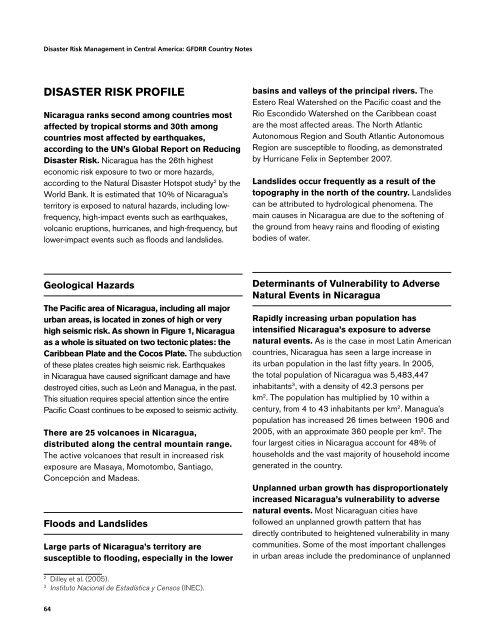Disaster Risk Management in Central America: GFDRR Country Notes
Disaster Risk Management in Central America: GFDRR Country Notes
Disaster Risk Management in Central America: GFDRR Country Notes
You also want an ePaper? Increase the reach of your titles
YUMPU automatically turns print PDFs into web optimized ePapers that Google loves.
<strong>Disaster</strong> <strong>Risk</strong> <strong>Management</strong> <strong>in</strong> <strong>Central</strong> <strong>America</strong>: <strong>GFDRR</strong> <strong>Country</strong> <strong>Notes</strong><br />
disaster risk profile<br />
Nicaragua ranks second among countries most<br />
affected by tropical storms and 30th among<br />
countries most affected by earthquakes,<br />
accord<strong>in</strong>g to the UN’s Global Report on Reduc<strong>in</strong>g<br />
<strong>Disaster</strong> <strong>Risk</strong>. Nicaragua has the 26th highest<br />
economic risk exposure to two or more hazards,<br />
accord<strong>in</strong>g to the Natural <strong>Disaster</strong> Hotspot study 2 by the<br />
World Bank. It is estimated that 10% of Nicaragua’s<br />
territory is exposed to natural hazards, <strong>in</strong>clud<strong>in</strong>g lowfrequency,<br />
high-impact events such as earthquakes,<br />
volcanic eruptions, hurricanes, and high-frequency, but<br />
lower-impact events such as floods and landslides.<br />
bas<strong>in</strong>s and valleys of the pr<strong>in</strong>cipal rivers. The<br />
Estero Real Watershed on the Pacific coast and the<br />
Rio Escondido Watershed on the Caribbean coast<br />
are the most affected areas. The North Atlantic<br />
Autonomous Region and South Atlantic Autonomous<br />
Region are susceptible to flood<strong>in</strong>g, as demonstrated<br />
by Hurricane Felix <strong>in</strong> September 2007.<br />
Landslides occur frequently as a result of the<br />
topography <strong>in</strong> the north of the country. Landslides<br />
can be attributed to hydrological phenomena. The<br />
ma<strong>in</strong> causes <strong>in</strong> Nicaragua are due to the soften<strong>in</strong>g of<br />
the ground from heavy ra<strong>in</strong>s and flood<strong>in</strong>g of exist<strong>in</strong>g<br />
bodies of water.<br />
Geological Hazards<br />
The Pacific area of Nicaragua, <strong>in</strong>clud<strong>in</strong>g all major<br />
urban areas, is located <strong>in</strong> zones of high or very<br />
high seismic risk. As shown <strong>in</strong> Figure 1, Nicaragua<br />
as a whole is situated on two tectonic plates: the<br />
Caribbean Plate and the Cocos Plate. The subduction<br />
of these plates creates high seismic risk. Earthquakes<br />
<strong>in</strong> Nicaragua have caused significant damage and have<br />
destroyed cities, such as León and Managua, <strong>in</strong> the past.<br />
This situation requires special attention s<strong>in</strong>ce the entire<br />
Pacific Coast cont<strong>in</strong>ues to be exposed to seismic activity.<br />
There are 25 volcanoes <strong>in</strong> Nicaragua,<br />
distributed along the central mounta<strong>in</strong> range.<br />
The active volcanoes that result <strong>in</strong> <strong>in</strong>creased risk<br />
exposure are Masaya, Momotombo, Santiago,<br />
Concepción and Madeas.<br />
Floods and Landslides<br />
Large parts of Nicaragua’s territory are<br />
susceptible to flood<strong>in</strong>g, especially <strong>in</strong> the lower<br />
Determ<strong>in</strong>ants of Vulnerability to Adverse<br />
Natural Events <strong>in</strong> Nicaragua<br />
Rapidly <strong>in</strong>creas<strong>in</strong>g urban population has<br />
<strong>in</strong>tensified Nicaragua’s exposure to adverse<br />
natural events. As is the case <strong>in</strong> most Lat<strong>in</strong> <strong>America</strong>n<br />
countries, Nicaragua has seen a large <strong>in</strong>crease <strong>in</strong><br />
its urban population <strong>in</strong> the last fifty years. In 2005,<br />
the total population of Nicaragua was 5,483,447<br />
<strong>in</strong>habitants 3 , with a density of 42.3 persons per<br />
km 2 . The population has multiplied by 10 with<strong>in</strong> a<br />
century, from 4 to 43 <strong>in</strong>habitants per km 2 . Managua’s<br />
population has <strong>in</strong>creased 26 times between 1906 and<br />
2005, with an approximate 360 people per km 2 . The<br />
four largest cities <strong>in</strong> Nicaragua account for 48% of<br />
households and the vast majority of household <strong>in</strong>come<br />
generated <strong>in</strong> the country.<br />
Unplanned urban growth has disproportionately<br />
<strong>in</strong>creased Nicaragua’s vulnerability to adverse<br />
natural events. Most Nicaraguan cities have<br />
followed an unplanned growth pattern that has<br />
directly contributed to heightened vulnerability <strong>in</strong> many<br />
communities. Some of the most important challenges<br />
<strong>in</strong> urban areas <strong>in</strong>clude the predom<strong>in</strong>ance of unplanned<br />
2<br />
Dilley et al. (2005).<br />
3<br />
Instituto Nacional de Estadística y Censos (INEC).<br />
64
















